
Rochelle Bailis, director of content, Hitwise
A recent study by Hitwise shows that in terms of online market share, Michael Kors, Ralph Lauren and Coach reign supreme as the most searched-for luxury brands (as seen on the left chart below). In fact, the three of them take 63.5% of the share of online visits to the luxury apparel industry. Louise Vuitton, Gucci and Chanel are the next major set of luxury players.
Yet, on the right Hitwise ranks the top luxury brands based on the percentage of their audience that is 18-34 years old. Several luxury brands that fell in the middle of the pack in the rankings on the left, such as Versace, Tom Ford and Yves Saint Laurent, emerge with the largest proportion of Millennials in their audience on the right:
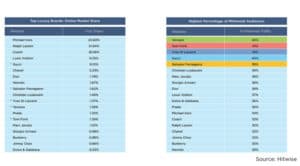
Millennial Market Share, Over Time
How did the top five Millennial luxury brands fare at capturing 18-34 year old luxury consumers over the course of a year in 2016? How did events, sponsorships and social media affect their ability to capture a larger market share of youthful consumers?
As you can see, Gucci captures a huge share of luxury Millennials, simply by way of being an older, larger company. Gucci has always maintained a youthful, edgy approach to high fashion, renowned for their progressive embrace of gender fluidity and androgyny, bold granny chic florals and Instagram-exclusive model interviews. However, it is interesting to note that Gucci struggles maintain their majority Millennial market share during the holiday season.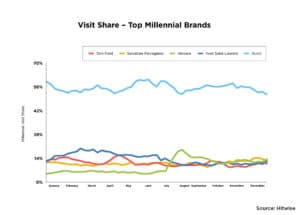
Meanwhile Versace—the luxury brand with the highest percentage of 18-34 year olds in their audience—saw a record jump in overall Millennial market share around June of 2016. It was during this time that superstars Gigi Hadid and Karlie Kloss modeled for Versace’s fall campaign; a few months later the youthful “Versus Versace” line announced their recruitment of Gigi’s popstar boyfriend, Zayn Malik.
Versace does an outstanding job leveraging megastars that young people idolize, and connecting with Millennials through racy videos, celebrity-laden social media content and digital experiences; Versace has similar traffic volume to Tom Ford, Yves Saint Laurent and Salvatore Ferragamo, and yet has more Instagram followers than all three combined.
Not All Millennials Are Created Equal
The term “Millennial” encompasses a vast, diverse segment of the population. 18-34 year olds includes young teenagers in high school, as well as 34-year-old career moms. How do these age demographics differ amongst luxury brands?
Versace’s audience skews heavily Millennial, but a little on the older side; they are 47% more likely than average population to be older Millennials (aged 25-34), and 32% more likely to be younger Millennials aged 18-24. There are also 23% more likely to be 35-44 year olds, which means Versace engages younger Gen X consumers as well.
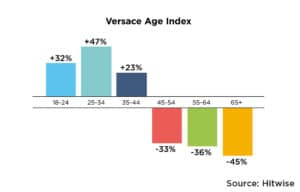 Meanwhile, although their Millennial index is not as high as Versace’s, Gucci skews youngest first. The Gucci audience is most likely to be 18-24 years old, followed by 24-35 year olds and a very small over-index for 35-44 year olds. The greatest segment by far is 18-24 year old women—they are 58% more likely than the average consumer to visit Gucci.com.
Meanwhile, although their Millennial index is not as high as Versace’s, Gucci skews youngest first. The Gucci audience is most likely to be 18-24 years old, followed by 24-35 year olds and a very small over-index for 35-44 year olds. The greatest segment by far is 18-24 year old women—they are 58% more likely than the average consumer to visit Gucci.com.
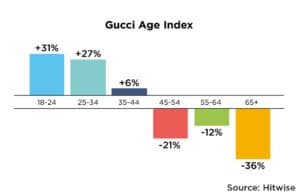 Compare the above to Michael Kors, the largest luxury brand with nearly a quarter of the entire digital luxury market share. Michael Kors is doing well with older Millennials, but noticeably failing to reach 18-24 year olds. Young Millennials are less likely to engage with Michael Kors than senior citizens are, which does not bode well for the future of their brand.
Compare the above to Michael Kors, the largest luxury brand with nearly a quarter of the entire digital luxury market share. Michael Kors is doing well with older Millennials, but noticeably failing to reach 18-24 year olds. Young Millennials are less likely to engage with Michael Kors than senior citizens are, which does not bode well for the future of their brand.
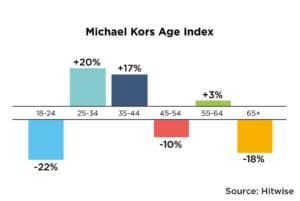 Obviously, this Millennial ‘lag’ has not caught up with brands like Michael Kors, Ralph Lauren or Coach quite yet; their share of 18-24 year olds may be relatively small, but their market share still looms very large within the luxury industry.
Obviously, this Millennial ‘lag’ has not caught up with brands like Michael Kors, Ralph Lauren or Coach quite yet; their share of 18-24 year olds may be relatively small, but their market share still looms very large within the luxury industry.
And yet, there are hints that edgier, more Instagram-savvy luxury brands may be capturing the attention of the next generation of luxury shoppers. The age of the luxury brand appears to be irrelevant; Michael Kors has only been around since the 80’s yet appears to have stagnated its hold on young consumers, while Gucci has been around for almost a century but manages to reinvent itself by pushing the boundaries of experimental, unapologetic fashion and modern marketing.
The fact is, Millennials care more about what luxury goods say about them than the luxury goods themselves. Luxury brands are about making a statement, creating an experience, building social capital and making an emotional connection to celebrities who lead incredible lives,” says Ms Bailis in summary. “To buy a Versace dress that Gigi Hadid wore is to feel part of her world, connected to something more glamorous, opulent and beautiful than ordinary life (and of course, to capture your abundance on social media for all your friends to see).
Source: Data pulled using Hitwise’s AudienceView tool, based on visitors to top luxury brand websites. Top luxury brand visit share and Millennial visit share lists pulled over the month of December, 2016. Millennial visit share graph charted over the year of 2016. Age demographics pulled over a 4-week period ending 2/18/2017.
Favorite
